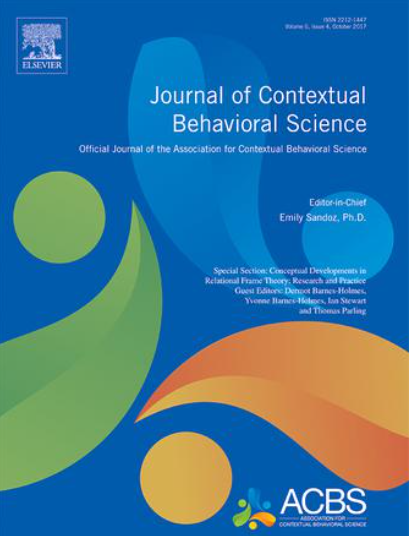Art in context: A multi-level analysis of art
IF 3
3区 心理学
Q1 PSYCHOLOGY, CLINICAL
引用次数: 0
Abstract
Experiencing art, both as the artist and observer, plays a major role in experiencing humanity. The current paper approaches art through a behavioral lens rooted in functional contextualism, where producing and observing art are behaviors that emerge and evolve within a multilevel functional context, encompassing natural selection, operant selection, and cultural selection. At the biological level, evolutionary pressures have shaped neurological processes and physiological responses that support artistic engagement. At the operant level, relational frame theory provides insights into how language and experience transform the function of art, and, bi-directionally, how art transforms human experience. At the cultural level, art propagates shared practices and values through mechanisms like metacontingencies and cultural cusps, facilitating intergenerational transmission and societal change. Potential applications include therapeutic interventions leveraging art to promote psychological flexibility, educational initiatives fostering artistic appreciation, and community programs enhancing collective resilience. By integrating biological, behavioral, and cultural perspectives, this analysis highlights art's unique role as a dynamic, adaptive component of human life, capable of enriching and transforming individual and collective experiences.
语境中的艺术:艺术的多层次分析
体验艺术,作为艺术家和观察者,在体验人性中起着重要的作用。本文通过植根于功能语境主义的行为视角来研究艺术,在功能语境中,艺术的产生和观察是在多层次的功能语境中出现和发展的行为,包括自然选择、操作性选择和文化选择。在生物学水平上,进化压力塑造了支持艺术参与的神经过程和生理反应。在操作层面,关系框架理论为语言和经验如何改变艺术的功能,以及艺术如何双向地改变人类经验提供了见解。在文化层面上,艺术通过元偶发和文化尖点等机制传播共同的实践和价值观,促进代际传播和社会变革。潜在的应用包括利用艺术促进心理灵活性的治疗干预,培养艺术欣赏的教育举措,以及增强集体弹性的社区项目。通过整合生物学、行为学和文化的观点,这种分析强调了艺术作为人类生活中动态的、适应性的组成部分的独特作用,能够丰富和改变个人和集体的经验。
本文章由计算机程序翻译,如有差异,请以英文原文为准。
求助全文
约1分钟内获得全文
求助全文
来源期刊

Journal of Contextual Behavioral Science
PSYCHOLOGY, CLINICAL-
CiteScore
8.50
自引率
18.00%
发文量
82
审稿时长
61 days
期刊介绍:
The Journal of Contextual Behavioral Science is the official journal of the Association for Contextual Behavioral Science (ACBS).
Contextual Behavioral Science is a systematic and pragmatic approach to the understanding of behavior, the solution of human problems, and the promotion of human growth and development. Contextual Behavioral Science uses functional principles and theories to analyze and modify action embedded in its historical and situational context. The goal is to predict and influence behavior, with precision, scope, and depth, across all behavioral domains and all levels of analysis, so as to help create a behavioral science that is more adequate to the challenge of the human condition.
 求助内容:
求助内容: 应助结果提醒方式:
应助结果提醒方式:


